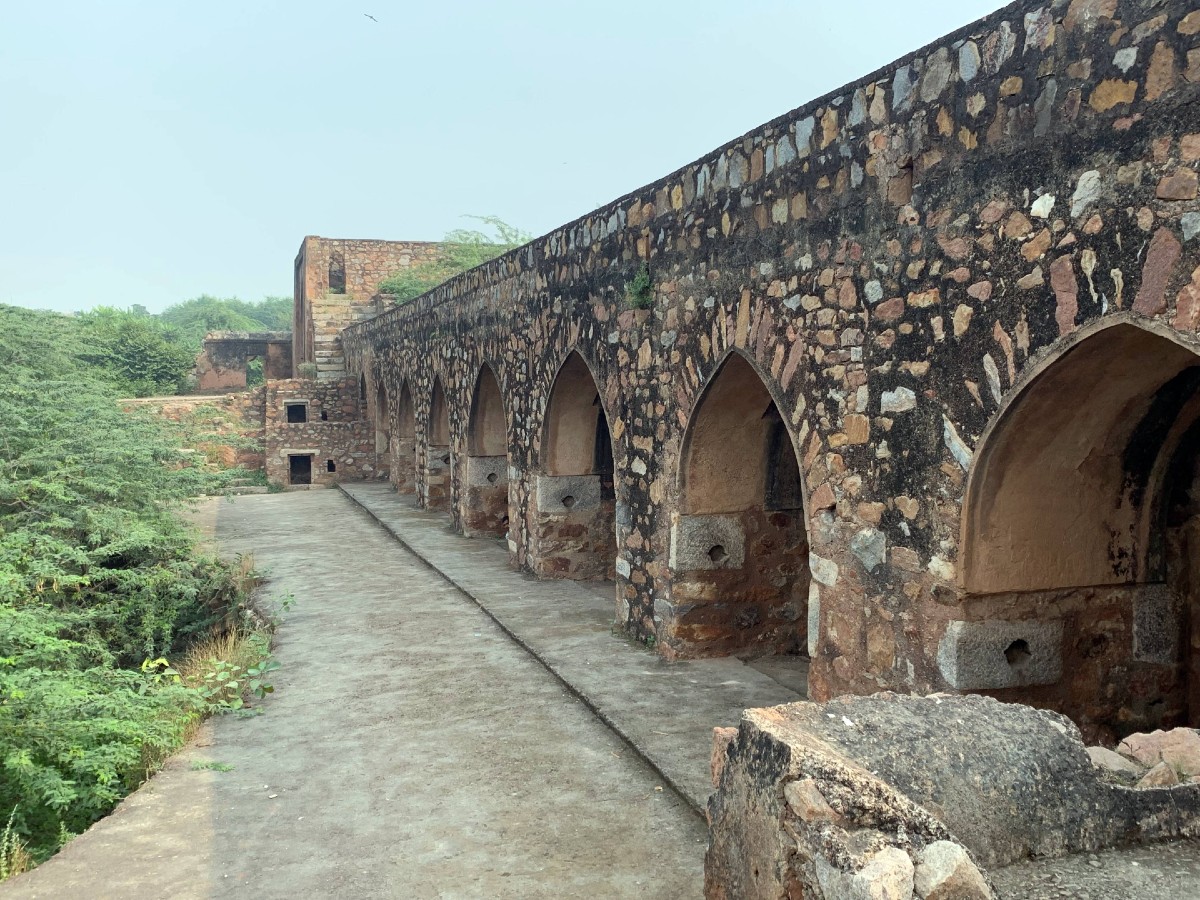
SULTANATE ERA: Built by Muhammad Bin Tughlaq to tap the local stream feeding on river Yamuna, the stone masonry is distinct and the structure, well planned.
A 15-minute ride from Malviya Nagar metro station takes one to Satpula, a 14th-century architecture that once acted as a weir (dam across a river to regulate its flow) as well as a defence during the reign of Mohammad bin Tughlaq.
“When Muhammad bin Tughlaq came to the throne of Delhi Sultanate, there were two areas of population in the Capital – one in Siri and the other in Mehrauli,” explains historian and author Swapna Liddle.
“There was a population that had settled outside these two cities. He built a wall across to connect the two cities of Siri and Mehrauli and protect the population living between these,” she explains.
Also read: Majnu Ka Tila – A Tibetan world in Delhi
The walls of Jahanpanah city, which was built by Muhammad bin Tughlaq, are part of this.
“The Satpula (which translates to seven spans or spaces between pillars) was basically a wall and it was a straight wall. Since there was a nullah (stream), they had to build sluiced gates to ensure that the water flowed in and out,” she adds further.
The structure worked not just as a safeguard but also as a dam and was utilised to gather water from the river Yamuna.
“The nullah was a natural one. It was used for irrigation. The gates were built to allow the nullah to flow into the city,” she adds further.
Seven of the stone dam’s eleven sluice gates and bays are on the ground level.
The slots in the side walls of each of the seven great arched gates, where the sliding wooden sluices would have fitted, can still be seen.
The two-storey-high bastions on either end, built like an octagon, are the most notable aspect of this site, although years of neglect have turned the site into a desolate ruin in desperate need of preservation.
Over the years, the area has turned arid due to the rising temperatures and irregular rainfall and a section of the lower wall on the interior side appears to have broken off. Satpula no longer fulfils the function of a dam.
Further, due to wear and tear, the plaster paint has come off. The neighbourhood boys using it as a playground as well as the encroachment it suffers has made things worse.
Although Satpula is no longer the cultural and geographical icon it once was, it nevertheless boasts of several noteworthy features.
The monument’s primary construction, which includes the seven arches and bastions connected with each other, remains very much intact and visible. However, the water tunnels beneath these seven arches have been destroyed. Each tunnel includes a secondary opening that can only be accessible if approached from the grazing ground.
“It was a utility structure built to let water in and out,” says A Vijaya who is the Director Programme with the Architectural Heritage Division, INTACH.
“There were innovative practices in water systems in that (Tughlaq) era. In fact, both Athpula and Barapula (in a dilapidated state now), which were built in Mughal era were inspired by the Satpula,” she adds.
Though both Athpula near Lodhi Gardens and Barapullah near Nizamuddin were inspired, they are not exactly the same as Satpula.
According to Swapna Liddle while both Athpula and Barapullah are bridges with roads on top meant for people to cross the river, Satpula is not a bridge as it has no road but only the sluiced gates. It was basically a part of the wall to protect the population.
Rana Safvi, a novelist and historian, says that the dam, also known as the seven-arched gate-controlled weir/dam, “was built to exploit the water resources of the nullah (stream/ravine), which could then be utilised to irrigate wide amounts of flat land. This method was also supposed to offer much-needed defence for Jahanpanah’s recently constructed city walls”.
Explaining it further, Rana says, “Muhammad bin Tughlaq’s rule was defined by catastrophic projects like moving the capital to Daulatabad and then returning, as well as conflicts with the Deccan monarchs. To alleviate the uncomfortable situation, immediate measures were required. Two natural disasters — a drought and political strategies that eventually backfired — made it difficult and Satpula also suffered due to it.”
One of the local beliefs is that the water of Satpula possessed healing properties because the Sufi saint Chiragh-e-Dehli used its water to perform ablution before prayers.
However, there is no water now since the nullah (or the stream) has changed its course. What is left now are just the ruins where people come for an outing or around which kids play.
Over the past century or so, the site, managed by the Archaeological Survey of India (ASI), has suffered encroachments and people have taken away stones and boulders for their private use.
Follow us on:
Instagram: instagram.com/thepatriot_in/
Twitter: twitter.com/Patriot_Delhi
Facebook: facebook.com/Thepatriotnewsindia
Rival leagues trigger players’ suspensions and a legal battle in Indian golf, for now
Former Delhi CM Kejriwal criticises Centre, Delhi govt over worsening air pollution, alleges AQI manipulation
Delhi Police raids Nangloi unit producing fake engine oil, seizes over Rs 1 crore worth…
Mukesh Sharma reimagines digital components as living matter in his solo exhibition ‘Decoding Digital DNA’
Nine accused were arrested in coordinated raids as police uncovered organised networks supplying mule bank…
Nearly 1.57 lakh PUC challans issued in two months as Delhi steps up GRAP enforcement…